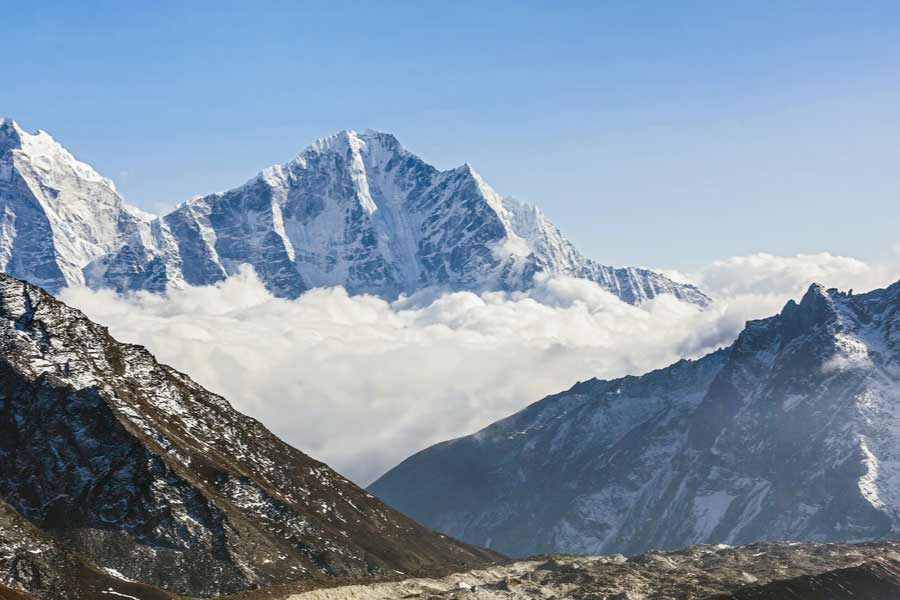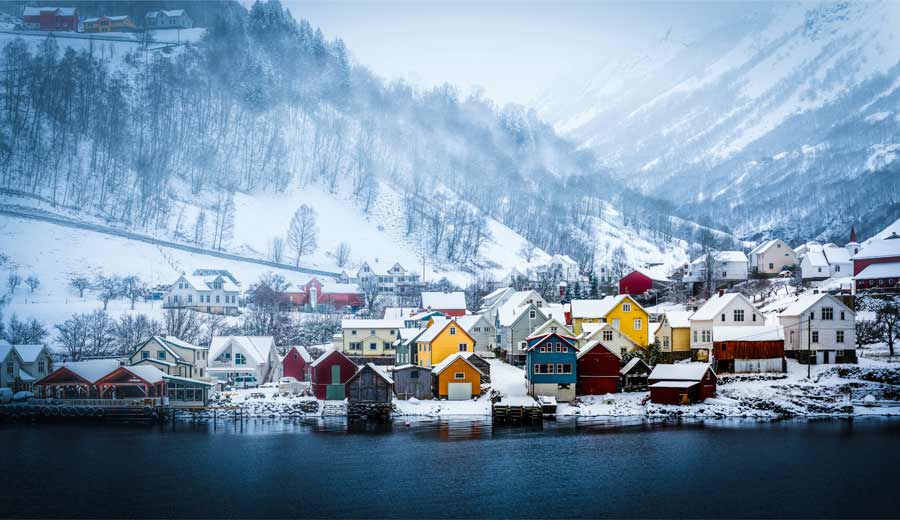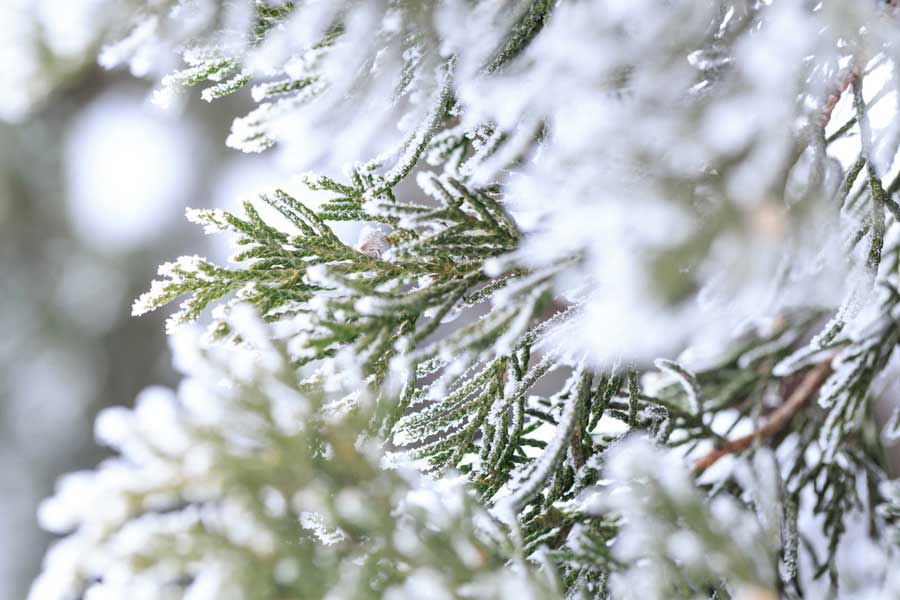Is It Ok To Leave A Camera In The Cold
Working in cold conditions presents problems for both photographers and their equipment. Cold-weather camera protection is disquisitional when shooting under these weather. Almost common cold-weather photography work will probably be done in the range from freezing down to 0 degrees F (-xviii degrees C), since not as well many places get much colder than that for more than a few days a year.
However, some areas have temperatures that go every bit low as -forty degrees. Equally I'm writing this in early on Jan, the temperature in Fairbanks, Alaska, is -31 degrees F/-35 degrees C, while the South Pole is at a relatively balmy -18 degrees F /-28 degrees C. If it gets below -40 degrees, I'd seriously think about staying indoors! However, most of those problems can be avoided Here are some tips from an expert on how to do wintertime photography.
1) Adjust Your Camera's Exposure During the Winter Weather

Drastic changes in temperature too accept a directly influence on photographic exposure. Exposure is usually insignificant to both film and digital cameras. The basic sensitivities of flick and digital sensors won't change much over the temperature range that you are likely to encounter. Though the cold doesn't appreciably change intrinsic movie speed, lower temperatures may significantly lessen reciprocity failure for moving-picture show, so some aligning of normal reciprocity correction factors may be needed for long exposures.
In extremely snowy conditions, where just about everything is white, you may need to punch in +1 or +two stops of exposure compensation if you want white snowfall to be white, and not an 18 percent heart grey. Remember that nigh auto exposure systems assume the scene they are metering is xviii pct grey and expose accordingly. Some may correct for the effulgence of snow in total sunlight when using an evaluative or matrix metering mode, and then in that case, you might not demand exposure compensation. Those shooting digital should review their images and check the image histogram to make certain that the exposure is giving the desired results. If all else fails, you can always fall back on incident metering!
Using a camera lens hood is another helpful accessory for protecting the front element of your lens from blowing or falling snow. Since snowfall tends to reflect the heaven, information technology can take on a bluish cast on a bright, sunny twenty-four hour period, especially in shadow areas, so a slight warming filter may help when shooting film.
You lot should too know your camera settings in snowy and common cold environments. When shooting digitally, be sure to modify your White Balance to open shade, which assumes a warmer hue due to the consequence of a blue sky. Even with digital, since the snowfall has a loftier UV reflectivity (80-ninety), using a UV filter tin can go a long way.
two) Go along Your Batteries Warm
Batteries lose a lot of their power at depression temperatures. While this applies to all batteries, some do ameliorate in low temperatures than others. The best common cold performance probably comes from primary (i.e., non-rechargeable) Li cells, followed past NiCd, NiMH, and Li-ion rechargeable batteries. They should all be fine down to -xx degrees C, though they will certainly have a lower chapters than they practice at higher temperatures. Most volition work for a while, even at lower temperatures.
If the batteries get cold and get depleted, they will normally regain power if warmed back up. Take at to the lowest degree two or three bombardment packs when shooting out in the field so that yous can switch them between your camera and a warm pocket to prolong their functionality under colder conditions.
Use Manus Warmers
Another way to keep your batteries warm is to wrap a small paw warmer around the section of the camera that contains the batteries (usually the handgrip for DSLRs). Hand Warmers are small packets containing iron powder mixed in with a few boosted chemicals, such every bit charcoal and salt. When the package is opened and exposed to air, oxygen reacts to the iron, forming atomic number 26 oxide (which is rust), releasing heat in the process. The reaction is quite boring, and the heat can last anywhere from six to 24 hours, depending on the size and design.
Since these are intended to be used to warm hands and feet, they don't get hot as much, which usually makes them safe to employ next to a camera.
Carrying a few extras for your hands and feet might not be a bad idea likewise! If you don't want to wrap ane effectually your camera and instead go on it inside a purse when non in use (meet "cold soaking," in a higher place), you can place a hand warmer in the bag adjacent to the photographic camera. It may not enhance the temperature in the bag much, just even a few degrees can help mitigate the effects of the cold. E'er recollect that keeping your camera common cold while as well keeping your battery warm is essential during wintertime photography sessions.

3) Encompass Common cold Soaking
During operation, digital cameras actually generate their own rut. With some early on digital cameras, after continuous functioning for a while, the batteries became near too hot to touch! Modern cameras are significantly more efficient and generate less estrus, but if you can continue that heat in the camera (by non cold soaking it), you may have fewer cold weather-related issues.
Common cold soaking is leaving a camera out in the cold until every part is at ambient temperature. This is likely to increase the probability of cold conditions-related issues. Since it tin can take quite a while for a photographic camera to fully cool, if you only expose your photographic camera to the very coldest temperatures when yous're shooting and put information technology in a pocket or a camera purse when it's non in employ, y'all'll probable have fewer issues than if you leave it permanently hanging effectually your neck and fully exposing it to the cold. Information technology may non be that much warmer in your pocket or your photographic camera purse, just every additional measure helps. (See also the department "Paw Warmers," below.)
1 affair to avert, though, is placing a common cold camera under your coat (peculiarly if yous've been sweating) every bit humid air becomes trapped nether your coat. This can happen even if you're wearing a highly insulated coat in cold weather condition and y'all've been working difficult, for example, past walking through deep snow. A cold photographic camera or lens in a humid environment tin can event in condensation of wet on both the optics and electronics, which is something best avoided. (See too "Coming in from the Cold" below).
4) Exist Careful Opening Anything Plastic
At boilerplate temperatures, plastics are, well, plastic. They volition bend a little, and some mechanisms depend on that such as plastic hinges and catches. Plastics may become quite brittle at very depression temperatures and volition suspension before they bend. This means you need to exist quite conscientious when opening any plastic camera coverings or hinges, like battery compartment doors, to avoid accidental damage.
v) Beware of Metal Surfaces
Touching metal at sub-freezing temperatures with your bare easily can be quite a painful experience. Moisture on your easily tin freeze and "gum" you to the metallic surface! Since most modern cameras are either plastic or plastic-covered, this isn't also much of a trouble when handing cameras, but touching blank metal tripod legs with ungloved hands tin can be a problem.
To avert this painful experience, you tin get insulating sleeves or pipe insulation for the legs of your tripod, or instead, use a carbon fiber tripod to prevent ice burn. If you demand more dexterity and find heavy gloves bulky, you can instead use thin silk glove liners at low temperatures to avoid using your bare easily. You tin likewise check other essential accessories for snow photography here and give yourself a more convenient experience when shooting in the snow or nether freezing temperatures.
For some camera systems, an external battery pack that connects to the photographic camera via a cable is an option. This ways you tin go on the batteries warm nether your jacket. However, the cablevision between the battery pack and the camera tin can be inconvenient. Note that alkaline metal batteries and particularly rechargeable element of group i batteries tend to underperform in colder conditions and should probably be avoided. Y'all can buy additional batteries and battery packs from the Adorama Battery Centre .

6) Protect Your Camera After Coming in from the Cold
A major problem with cold-atmospheric condition shooting can occur not while you are exterior, simply when y'all come back into a heated area. Common cold air is much drier, while the warm air inside a heated room oft contains much more moisture. In fact, many homes utilize a humidifier during the wintertime months to go on the air moist because information technology'due south more comfortable for people.
If you bring a very cold camera and lens into a room with warm, moist air, moisture will condense out of the air and onto the cold surfaces. The trouble isn't so much the moisture you may run across on the outside of the camera or lens, but the moisture that condenses within its internal parts. Electronics and moisture don't mix well, and yous really don't want condensation on the inner elements of lenses either.
The good news is that the moisture will eventually evaporate if the equipment is allowed to warm upward to room temperature. It might, nonetheless, take a long time. You can gently warm the gear with a hairdryer on a low setting to speed things up, but a much ameliorate process is preventing the moisture from condensing in the first place.
If you practice get condensation on a camera, remove the batteries and don't supervene upon them until you are sure the camera has dried out. Simply considering a photographic camera is "off" doesn't hateful that electronics are safe from harm. Many cameras are only in a "sleep" land when off, with ability however applied to some components.
You can avoid issues if you seal your camera gear in an airtight plastic handbag before you bring it inside. It will then be surrounded only by the very dry air from outdoors. You may get some condensation on the outside of the handbag, just the photographic camera or lens will slowly warm upward in dry air inside the bag and will stay dry. Self-sealing freezer bags piece of work well for this, only whatsoever container which you can seal will also exercise the fox. Just exist certain to put the photographic camera and lens in the bag earlier y'all go indoors. Once you lot're indoors, it's too late!
Should You Worry About Memory Cards in the Cold?
There are very few reports of memory cards having bug in depression temperatures. Some industrial cards are thoroughly tested and specified for continuous utilize at temperatures downwards to -forty degrees C, but it seems that it'south really not essential to use such cards. The Sandisk Farthermost retention cards are specified for use down to -25 degrees C, but even they are probably not required.
Near users seem to find that even at the lowest temperatures, about retentivity cards perform without bug.
I'd be a picayune wary of compact flash microdrives at low temperatures since they are mechanical devices and will most likely have cold weather-related bug. Fortunately, few cameras these days use microdrives.
Tips for Your LCDs in the Common cold
LCDs (Liquid Crystal Displays) are also affected by low temperatures. LCDs may lose contrast and grey out, change the displayed information more slowly, and get quite sensitive to touch. Pressing on them may even cause the display to alter colour. Thankfully, these issues are reversible one time the LCD warms up.
Do Yous Demand to Winterize Your Cameras and Lenses?
Older mechanical lenses and cameras had to be "winterized" for apply at low temperatures. Winterizing such equipment involved taking them autonomously and removing the heavy lubricants from their mechanical parts. This was either replaced with a very low viscosity lubricant or no lubricant at all. Before they could be used over again at normal temperatures, they had to exist taken apart once more to replace the lubricants inside! This was not very convenient and, thankfully, not necessary for today's cameras.
Mod digital cameras and lenses don't typically use much internal lubrication, and certainly not the gummy grease and oil used with earlier fully mechanical designs. Consequently, the blueprint and temperature range for digital cameras takes into account drops in temperatures, which means these modern cameras don't need any special winterizing for operation in common cold conditions.
How Common cold is too Cold for my Camera?
Near cameras today are cold-proof and can function upward to 32 degrees F, or 0 degrees C. Some cameras also have freeze-proof certifications and specialized weather condition-sealed bodies, similar those made of magnesium-alloy, to brand them handle the common cold atmospheric condition meliorate.
Keep in mind that while cameras can often handle more frigid temperatures, batteries are more susceptible to changes in temperature. In fact, a drop of x degrees C (eighteen degrees F) can significantly deplete your battery life. Hence, you lot should remember to bring extra batteries with yous, particularly when working in colder weather condition.
Tips for Photographing Snow and Snowfall Storms
During active snow, information technology's a good thought to employ your lens hood to stop falling snow from leaving streaks or droplets on the front chemical element of your lens. Keep a lens cloth handy simply in case y'all demand to clean up between shots.
If you want to capture the snowflakes falling in the scene, you can either take advantage of a fast shutter speed to freeze the snowflakes in motion, or drag the shutter merely a scrap to create streaks of falling snowfall. If you desire to achieve a "snowkeh" issue, employ the pop-up flash to illuminate the snow in the foreground.
Tips for Photographing Wintertime Landscapes
Winter landscapes are often far less textured than during other times of year. To create interesting compositions, consider making utilise of the negative space created by big swaths of snow. Search for striking shadows, sources of contrast, and other objects in the scene to help create interest in the frame.
During active snow, the sky is ofttimes unremarkable and overwhelmingly white or gray. Consider raising the horizon in the frame to focus on more attractive elements. Many snowscapes lend themselves well to black-and-white photography, so look for eye-friendly shades of greyness in the scene.
How to Use Film for Winter Photography
In that location are two problems related to using film at depression temperatures. The first is that at very low temperatures, the film can become brittle. If y'all curve it besides much, it may actually snap, which means loading a picture camera requires extra care. The 2nd trouble when using moving picture nether low temperatures is the low humidity of common cold air.
The dry out air allows static electricity to build up on the movie surface, which may crusade complications when rewinding the camera. You lot can actually go a static discharge and sparks inside the photographic camera, which leaves marks on the movie. The slower you wind and rewind, the less probable you are to meet problems from either breakable film or static discharge. Of grade, on many modernistic cameras, y'all have no choice near winding or rewinding speed, so in that location's not much you can do nearly it.
What are Some of the All-time Cameras for Wintertime Photography?
Streamlined camera bodies with elaborate menus offering enough of features and opportunities for setting adjustments. Yet, the easiest cameras to operate in cold weather take reward of defended, tactile buttons, switches, and dials. Touchscreens are frequently choosy in cold weather, and so if you plan to practise lots of wintertime shooting outdoors, information technology'southward a adept idea to consider cameras that allow menu admission across using the touchscreen.
Battery life is another important consideration. Mirrorless cameras are known for using up lots of bombardment with their electronic viewfinders and live view displays. Consider sticking to a mechanically-based DSLR for improved battery performance during cold conditions shooting.
When shopping for a new cold weather condition camera, consider taking it for a test run with your gloves on. Meet if y'all can comfortably alter the settings while keeping your easily and fingers warm. Does the photographic camera feel prophylactic and secure in your gloved hands? Or is information technology bad-mannered and difficult to grip? By doing a test run, if information technology'southward possible, yous'll be much more comfortable once it'southward time to purchase the camera.
Source: https://www.adorama.com/alc/winter-photography-tips-protect-your-gear-in-extreme-cold-2/
Posted by: farrgivename.blogspot.com


0 Response to "Is It Ok To Leave A Camera In The Cold"
Post a Comment